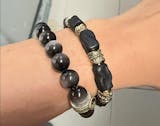Thangka Pendants: Taboos, Care, and Preservation
Introduction
Thangka pendants are exquisite pieces of art imbued with deep spiritual significance, often depicting revered Buddhist deities and symbols. While wearing these pendants can bring blessings and positive energy, it's essential to observe certain taboos and take proper care to preserve their beauty and sanctity. In this article, we'll delve into the taboos associated with wearing Thangka pendants and offer tips for their care and preservation.

Taboos of Thangka Pendants
Respectful Handling: Thangka pendants are delicate artworks that require gentle handling. Avoid pulling on the pendants or subjecting it to rough treatment, as this can damage the intricate details and symbolism.
Avoiding Water and Moisture: Thangka pendants are not waterproof or moisture-resistant. Avoid wearing them while bathing or swimming to prevent water damage and preserve the integrity of the pendants' materials.
Protection from Sunlight: Prolonged exposure to sunlight can cause fading and deterioration of the colors and materials used in Thangka pendants. Store them in a cool, dark place when not in use and avoid exposing them to direct sunlight for extended periods.
Cleanliness and Hygiene: While wearing Thangka pendants, maintain personal cleanliness and hygiene to honor their sacredness. Avoid wearing them in dirty or unhygienic environments to prevent contamination and preserve their purity.
Cultural Sensitivity: Thangka pendants are deeply rooted in Tibetan Buddhist culture and tradition. Respect their cultural significance and the beliefs of the people who created them. Avoid wearing them inappropriately or disrespectfully.

Care and Preservation Tips:
Store in a Dry Place: When not wearing your Thangka pendant, store it in a dry, clean place to prevent moisture damage and maintain its quality.
Clean with Care: Use a soft, dry cloth to gently wipe the pendant clean of any dust or debris. Avoid using harsh chemicals or cleaning agents that may damage the materials.
Handle with Caution: When handling your Thangka pendant, be mindful of its delicate nature. Avoid pulling on the pendant or subjecting it to rough treatment that could cause damage.
Professional Restoration: If your Thangka pendant shows signs of damage or deterioration, consider consulting a professional restorer who specializes in the preservation of cultural artifacts.

Conclusion:
Thangka pendants are not only beautiful adornments but also sacred symbols of Tibetan Buddhist culture and spirituality. By observing the taboos associated with wearing them and taking proper care to preserve their beauty and sanctity, we can honor their cultural significance and ensure that they remain treasured pieces for generations to come.
Related Articles:
The Profound Benefits of Kalachakra Thangka Paintings
How to Use Buddhist Prayer Beads for Meditation
The Signficance and Benefits of Kalachakra Mandala Thangka Art

























































